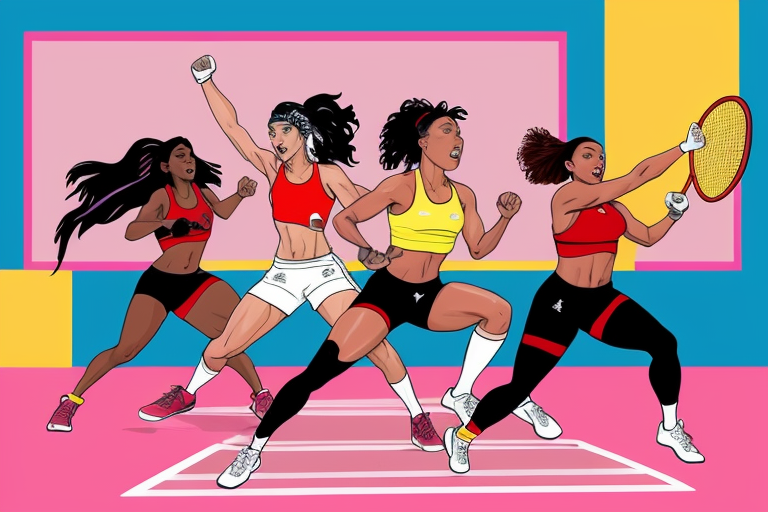The Rise of Women’s Sports
Women’s sports have come a long way in the past century. In the early 1900s, women were not allowed to participate in many sports, and those that were allowed were heavily regulated and restricted. However, as time went on, women began to fight for their right to play sports and be recognized as athletes.
In the 1960s and 1970s, the women’s liberation movement helped to pave the way for women’s sports. Title IX, a federal law passed in 1972, prohibited discrimination on the basis of sex in any educational program or activity receiving federal financial assistance. This law helped to increase the number of female athletes in schools and universities across the United States.
Since then, women’s sports have continued to grow and evolve. Female athletes have shattered records and broken barriers, proving that they are just as capable as their male counterparts. Today, women’s sports are more popular than ever, and female athletes are inspiring a new generation of young girls to pursue their dreams.
Purpose of the Article
The purpose of this article is to highlight the rise of women’s sports and the impact it has had on society. We will explore the challenges that female athletes have faced, the economic impact of women’s sports, and the importance of female role models in sports. Through interviews with top female athletes, we hope to inspire and empower young girls to pursue their passions and break down barriers in the world of sports.
This article is not just about sports; it’s about gender equality and the fight for women’s rights. By discussing women’s sports, we are shedding light on the larger issues of discrimination and inequality that women face in all areas of life. We hope that this article will spark important conversations and encourage people to support female athletes and their achievements.
Breaking Barriers: Female Representation in Sports
The world of sports has long been dominated by men, but in recent years, we have seen a significant increase in female participation rates. According to a report by the Women’s Sports Foundation, the number of high school girls playing sports has increased by over 1,000% since the passage of Title IX in 1972. This increase in participation has led to a rise in female representation in sports media and leadership roles.
One example of a female athlete breaking barriers in sports is Frankie Rodriguez, a professional soccer player who has played for the US Women’s National Team. Frankie has not only excelled on the field but has also become a role model for young girls who aspire to play soccer professionally. She has used her platform to advocate for equal pay for female athletes and has been a vocal supporter of women’s sports.
It is essential to have female representation in sports media and leadership roles to ensure that the voices of female athletes are heard. Women like Jessica Mendoza, a former Olympic softball player who now works as an analyst for ESPN, have paved the way for other women to break into the male-dominated world of sports media. Having women in leadership roles also helps to create a more inclusive and diverse environment in sports.
Female role models in sports are crucial for inspiring young girls to pursue their athletic dreams. Serena Williams, one of the greatest tennis players of all time, has been an inspiration to many young girls who dream of playing tennis professionally. She has shown that with hard work and dedication, anything is possible, regardless of gender.
It is not just the professional athletes who are making a difference in the world of sports. Female coaches, referees, and administrators are also breaking barriers and paving the way for future generations of female athletes. The son of a female coach or referee can grow up seeing women in leadership roles and knowing that they too can achieve their dreams.
Overcoming Challenges in Women’s Sports
Female athletes face numerous challenges in their sports, ranging from stereotypes and discrimination to unequal treatment and pay discrepancies. Despite these obstacles, female athletes continue to push boundaries and pave the way for future generations of women in sports.
One of the most significant challenges that female athletes face is the physical demands and endurance required for their sports. For example, female gymnasts must perform intricate routines that require immense strength and flexibility, while female marathon runners must endure grueling training regimes and races that test their mental and physical limits. These physical demands can take a toll on female athletes’ bodies, leading to injuries and health issues.
In addition to the physical challenges, female athletes also face stereotypes and discrimination in their sports. For example, female basketball players may be told that they are not as skilled or athletic as their male counterparts, while female soccer players may be criticized for being too aggressive on the field. These stereotypes can affect how female athletes are perceived and treated by their coaches, teammates, and fans.
Another challenge that female athletes face is unequal treatment and pay discrepancies in professional sports. For example, female soccer players in the United States have been fighting for equal pay for years, as they receive significantly less compensation than their male counterparts. This unequal treatment can also extend to opportunities for endorsements and sponsorships, as male athletes often receive more lucrative deals than female athletes.
Despite these challenges, female athletes continue to break barriers and inspire future generations of women in sports. For example, tennis player Serena Williams has won 23 Grand Slam singles titles, making her one of the most successful athletes of all time, male or female. Female athletes like Williams serve as role models for young girls who aspire to succeed in sports and show that anything is possible with hard work and dedication.
The Economic Impact of Women’s Sports
Women’s sports have come a long way in terms of economic impact. In the past, women’s sports were often overlooked, and female athletes faced many economic challenges. However, in recent years, the economic impact of women’s sports has increased significantly. This section will explore the economic impact of women’s sports, including the increase in viewership and media coverage, growth in sponsorships and endorsements, and rise in merchandise sales.
One of the most significant changes in the economic impact of women’s sports is the increase in viewership and media coverage. In the past, women’s sports were often relegated to the sidelines, with little to no media coverage. However, in recent years, there has been a significant increase in media coverage of women’s sports, with major networks like ESPN and Fox Sports dedicating more airtime to women’s sports. This increase in media coverage has led to a rise in viewership, with more people tuning in to watch women’s sports.
Along with the increase in media coverage and viewership, there has also been a growth in sponsorships and endorsements for female athletes. In the past, female athletes often struggled to secure sponsorships and endorsements, with companies preferring to invest in male athletes. However, in recent years, there has been a shift in the sponsorship landscape, with more companies recognizing the value of investing in female athletes. This increase in sponsorships and endorsements has not only benefited female athletes but has also helped to raise the profile of women’s sports.
Another significant change in the economic impact of women’s sports is the rise in merchandise sales for women’s sports teams and individual athletes. In the past, merchandise sales for women’s sports were often minimal, with little demand for women’s sports apparel and accessories. However, in recent years, there has been a significant increase in merchandise sales for women’s sports, with more people purchasing apparel and accessories to support their favorite female athletes and teams.
Despite these positive changes, female athletes still face economic challenges, including unequal treatment and pay discrepancies in professional sports. However, there have been some notable victories in this area, such as the recent ruling by a judge in favor of equal pay for female athletes. This ruling has the potential to significantly impact the economic landscape of women’s sports, as it sends a message that female athletes deserve equal treatment and pay.
One female athlete who has overcome economic challenges is Frankie, a professional soccer player. Frankie grew up in a low-income household and struggled to afford the costs associated with playing soccer. However, she was determined to pursue her dream of becoming a professional athlete and worked hard to secure a spot on a professional team. Despite facing economic challenges, Frankie has become one of the top female soccer players in the world and has secured several sponsorships and endorsements.
Insights from Top Female Athletes
Female athletes have come a long way in breaking down barriers and achieving success in their respective sports. From Simone Biles to Megan Rapinoe, these women have shown that they are just as capable as their male counterparts. In this section, we will hear from some of the top female athletes in their fields and gain insights into their experiences and advice for aspiring athletes.
Frankie Uvanni, a professional soccer player for the US Women’s National Team, shares her experience of overcoming challenges and stereotypes as a female athlete. “Growing up, I was always told that soccer was a ‘boy’s sport’ and that girls couldn’t play as well as boys. But I didn’t let that stop me. I worked hard and proved that I was just as good, if not better, than the boys.”
Simone Biles, a world-renowned gymnast and Olympic gold medalist, shares her advice for aspiring athletes. “My advice to young girls who want to pursue sports is to never give up on your dreams. There will be challenges and setbacks, but you have to keep pushing through. And always remember to have fun and enjoy the journey.”
Serena Williams, a tennis legend and 23-time Grand Slam winner, shares her experience of being a female athlete and a mother. “Being a mother and a professional athlete is not easy, but it’s definitely possible. It takes a lot of hard work and dedication, but it’s worth it. And I hope that my daughter sees that and knows that she can do anything she sets her mind to.”
These female athletes serve as role models for young girls and women everywhere. They have shown that with hard work, dedication, and perseverance, anything is possible. And they have paved the way for future generations of female athletes to achieve even greater success.
Inspirational stories from female athletes like Frankie, Simone, and Serena show that women can achieve anything they set their minds to. They have broken down barriers and shattered stereotypes, paving the way for future generations of female athletes. And their advice for aspiring athletes is invaluable, reminding us that with hard work, dedication, and perseverance, anything is possible.
So let us continue to support and celebrate the achievements of female athletes everywhere, and work towards a future where gender equality in sports is the norm.
The Future of Women’s Sports
Women’s sports have come a long way in recent years, with increased participation rates, media coverage, and economic impact. However, there is still much work to be done to ensure that female athletes receive the recognition and support they deserve. Looking ahead, there are several key areas where women’s sports can continue to grow and thrive.
One of the most important factors in the future of women’s sports is inclusivity and diversity. While progress has been made in terms of gender equality, there is still a lack of representation for women of color, LGBTQ+ athletes, and athletes with disabilities. It is crucial that we work to create a more inclusive and diverse sports culture, where all athletes are given the same opportunities to succeed.
Another area where women’s sports can continue to grow is in terms of media coverage and sponsorship. While there has been an increase in coverage and sponsorships for female athletes, there is still a significant gap between men’s and women’s sports. By increasing media coverage and sponsorships for women’s sports, we can help to create a more level playing field and provide female athletes with the resources they need to succeed.
In addition to increasing media coverage and sponsorships, it is also important to focus on grassroots initiatives and development programs for young female athletes. By providing opportunities for young girls to get involved in sports and encouraging them to continue playing as they grow older, we can help to create a pipeline of talented female athletes who can compete at the highest levels.
Finally, it is important to continue to push for gender equality and fair treatment for female athletes. This includes addressing issues such as pay disparities and unequal treatment in professional sports. By advocating for equal treatment and opportunities for female athletes, we can help to create a more just and equitable sports culture for all.









